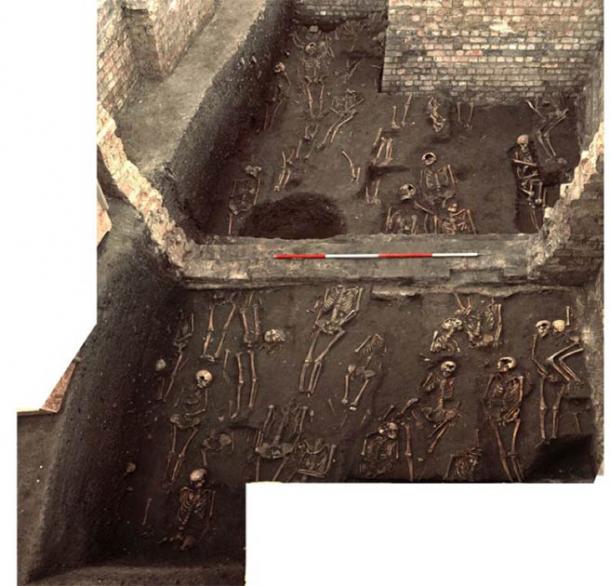
Skeletal Trauma Reveals Class Inequality in Medieval Cambridge
Skeletal trauma has been studied in the remains of hundreds of people who lived in medieval Cambridge excavated from three cemeteries dating back to between the 10th and 14th century. The study has revealed varying levels of physical hardship across lower classes.
Founded in 1209 AD and granted a royal charter by Henry III in 1231 AD, Cambridge is a university city on the River Cam in Cambridgeshire, England, located approximately 89 kilometers (55 miles) north of London. The city hosts the second oldest university in the English-speaking world, which is also the world's fourth oldest surviving university, however, while today the city homes the poshest of England’s financial and intellectual elite, it was not always this way. In fact, according to a new study, for hundreds of years, life in the city was quite the opposite. It could even be described as hellish.

Image showing the remains of numerous individuals who lived in medieval Cambridge unearthed on the former site of the Hospital of St. John the Evangelist, taken during the 2010 excavation. (Cambridge Archaeological Unit / St John’s College)
Reading Lifestyle Differences from Bone Trauma Marks in Medieval Cambridge
A new paper published in the American Journal of Physical Anthropology presents the results of a study of the bones of “314 individuals dating from the 10 th to the 14 th century,” excavated from three burial sites in Cambridge. The skeletal samples were taken from a parish graveyard where working people were buried, a hospital graveyard where the infirm and destitute were buried, and from an Augustinian friary where wealthy sponsors were interred beside rich clergymen. The researchers studied the levels of skeletal trauma in the skeletons, which they say indicated "the hardship endured in life.” Their paper concludes that “social inequality is recorded on the bones of Cambridge’s medieval residents”.

Members of the Cambridge Archaeological Unit at work on the excavation of the Hospital of St. John the Evangelist in 2010. (Cambridge Archaeological Unit)
Using x-ray analysis, the researchers looked at bone breaks and fractures building a clear picture of the physical stresses including accidents, occupational injuries and violence endured between the 10th to the 14th century. The study shows that “44% of working people had bone fractures, compared to 32% of those in the friary and 27% of those buried by the hospital.” Furthermore, fractures were “40% more common in males than females.”
- More than 1,000 Ancient Skeletons found beneath Cambridge University
- Face of ‘Ordinary Poor’ Man from Medieval Cambridge Graveyard Revealed
- An Elite Class That Ruled Over the 99%. Sound Familiar? It All Began with the Patricians of Rome
It was noted that ordinary working folk had “a higher risk of injury compared to the friars and their benefactors or the more sheltered hospital inmates.” This contrasts with the bones of poor folk laboring in town and working trades like stonemasonry and blacksmithing, and with the skeletal trauma measured on the bones of farmers.

Dr. Jenna Dittmar at work on the After the Plague Project at the University of Cambridge’s Department of Archaeology looks at bones dating from medieval Cambridge. (University of Cambridge)
The Bishop and the Battered Woman
Dr. Jenna Dittmar from the After the Plague Project at the University of Cambridge’s Department of Archaeology was lead author of the new study. The professor wrote that by comparing the skeletal trauma of remains buried in various locations within a city like Cambridge, “we can gauge the hazards of daily life experienced by different spheres of medieval society”. The researcher noted several stand-out cases that the team found during the research including: the remains of a church friar resembling “a modern hit-and-run victim, and bones that hint at lives blighted by violence.” The friar had complete fractures halfway up both his femurs and it was concluded that whatever caused both bones to break in this way “must have been traumatic, and was possibly the cause of death,” said Dittmar.

X-rays of butterfly fractures to both femora of an adult male buried in the Augustinian friary in medieval Cambridge. (Dr. Jenna Dittmar / University of Cambridge)
In another singular case, the skeleton of an older woman who had been buried in the parish grounds had “a lot of fractures.” What’s more, all of her breaks and fractures had healed a long time before her death. This was interpreted as evidence of “lifelong domestic abuse.” Highlighting the horrors this woman endured, the paper says “several of her ribs had been broken as well as multiple vertebrae, her jaw and her foot,” wrote Dittmar. The scientist added that the vast majority of broken jaws seen in women are caused by “intimate partner violence.”
The new paper suggests that “this inequality” found recorded on the bones of medieval Cambridge residents shows “trauma was prevalent across the social spectrum.” However, it shows that life was undoubtedly tougher at the bottom of the social ladder, and that it got much, much easier as one moved up the ranks in terms of income and class. In other words, nothing much has changed over the last 800 years.
Top image: The remains of an individual buried in the Augustinian friary, taken during the 2016 excavation. Source: Nick Saffell / University of Cambridge
By Ashley Cowie
















Comments
Did these people have a degree in stating the bleeding obvious ??
WarwickLewis